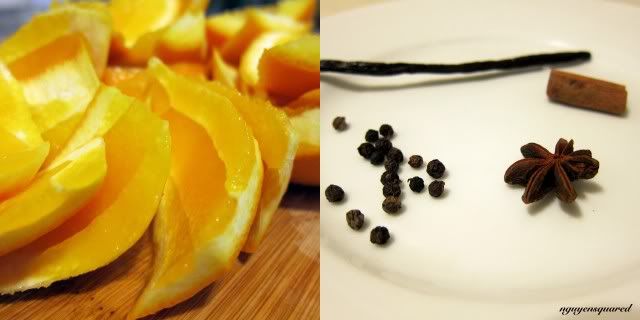I'm in the Big Apple on a rainy day so instead of happily strolling around I'm sitting here writing this post. I am not quite sure which category to put this one in: snacks? candies? Hmm!!! But I suppose that's minor detail.
I think partly because most people don't usually candy anything. As a result, they are afraid of it and are easily impressed by people who do. In the past, when families spent time rather than money to prepare for lunar new year in Vietnam, they candied a lot of different fruits/roots, the most common being thin ginger slices, thicker slices of coconut "meat", etc. We do this by cooking the fruits in sugar (the fruits normally release enough liquid) until the sugar has completely dissolved. We then continue to cook over low heat until the moisture evaporates and the sugar recrystallizes, forming a coat on the slices. For citrus fruits such as kumquats or tangerine rinds, we only cook till most of the liquid is gone but the fruits are still moist and sticky. The Vietnamese grandmothers are definitely not afraid of candying fruits :))
However, the recipe I'm going to post is not what Vietnamese usually do when candying fruits. Is is a slight adaptation of Pierre H's recipe. It can be used to candy 4 grapefruits, 5 oranges, or 6 lemons. I have not tried candying lemon peels simply because I didn't have a need for that much left-over lemon juice. Maybe if I decide to make lemonade one of these days then I will try candying lemon peels. I find that the grapefruit rinds are thicker but softer than the orange ones when candied. I personally prefer the texture of candied orange peels but you can choose whatever one you like. The candying process takes a bit of time but the active time is not long so you should definitely not be afraid of doing this.
INGREDIENTS:
5 oranges
450g sugar
1L or 1kg (or 1000g) water
1 plump, moist vanilla bean
1 star anise
~15 black peppercorns, bruised
Apart from the sugar and water (which can almost always be found in any kitchen), the rest of the ingredients can be summarized in this photo.
METHOD:
Bring a pot of water to a boil. Meanwhile, make two thin slices on the ends of each orange, then cut the peels into strips of about 1-in in width, make sure that you include a sliver of the orange pulp in each strip. When the water boils, place the orange peels into the pot, let boil for 2 minutes. Get a colander ready. Remove the orange peels to the colander and run cold water through them for 2 minutes. This process is called blanching. Do not discard the boiling water as you need to repeat the blanching process two more times. The effect is to remove the strong bitter taste from the peels.
Split the vanilla bean lengthwise and scrape off the pulp. Place both the pulps and the pod together with the rest of the ingredients in a lidded cooking vessel large enough to accommodate everything and cook over medium high heat to bring the water to a boil. Stir briefly to make sure the sugar dissolves. Once the mixture comes to a boil, add the blanched peels and reduce the flame so that the water simmers gently. Cover and let the peels cook for about 1.5 hours. Stir occasionally.
Turn off the heat and let the peels macerate in the cooking liquid overnight. Then, the peels can be kept in a jar together with the cooking liquid in the refrigerator for up to 3 weeks. They can be chopped up and used in other recipes or dried on a rack overnight before being rolled in sugar or dipped in chocolate. The cooking liquid can be strained and reduced to the desired consistency before being served over pancakes.
Bring a pot of water to a boil. Meanwhile, make two thin slices on the ends of each orange, then cut the peels into strips of about 1-in in width, make sure that you include a sliver of the orange pulp in each strip. When the water boils, place the orange peels into the pot, let boil for 2 minutes. Get a colander ready. Remove the orange peels to the colander and run cold water through them for 2 minutes. This process is called blanching. Do not discard the boiling water as you need to repeat the blanching process two more times. The effect is to remove the strong bitter taste from the peels.
Split the vanilla bean lengthwise and scrape off the pulp. Place both the pulps and the pod together with the rest of the ingredients in a lidded cooking vessel large enough to accommodate everything and cook over medium high heat to bring the water to a boil. Stir briefly to make sure the sugar dissolves. Once the mixture comes to a boil, add the blanched peels and reduce the flame so that the water simmers gently. Cover and let the peels cook for about 1.5 hours. Stir occasionally.
Turn off the heat and let the peels macerate in the cooking liquid overnight. Then, the peels can be kept in a jar together with the cooking liquid in the refrigerator for up to 3 weeks. They can be chopped up and used in other recipes or dried on a rack overnight before being rolled in sugar or dipped in chocolate. The cooking liquid can be strained and reduced to the desired consistency before being served over pancakes.

No comments:
Post a Comment